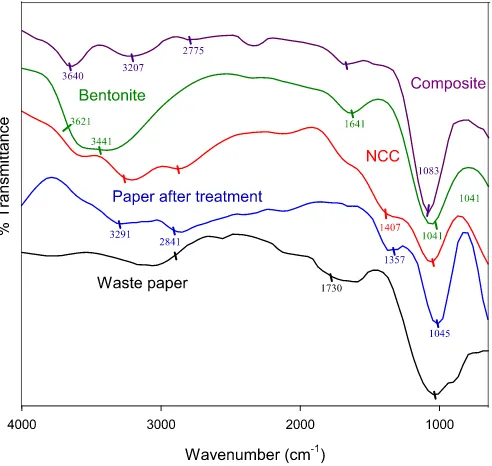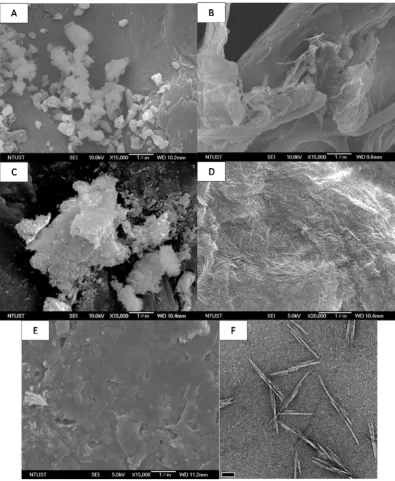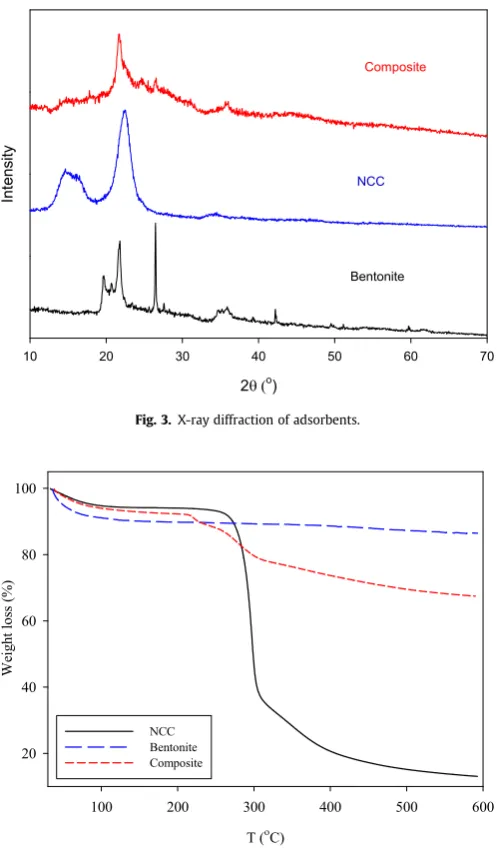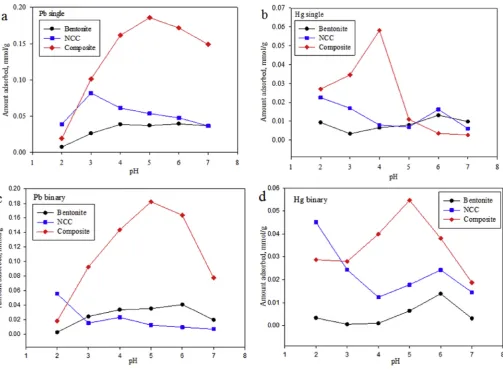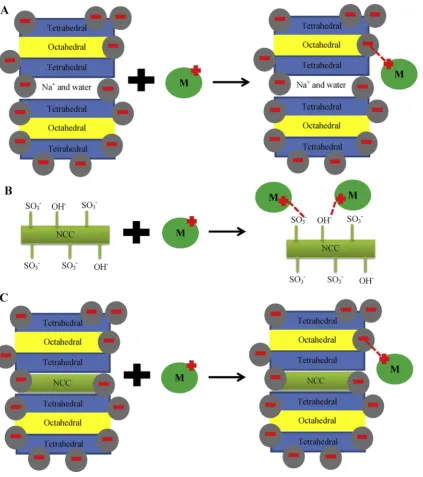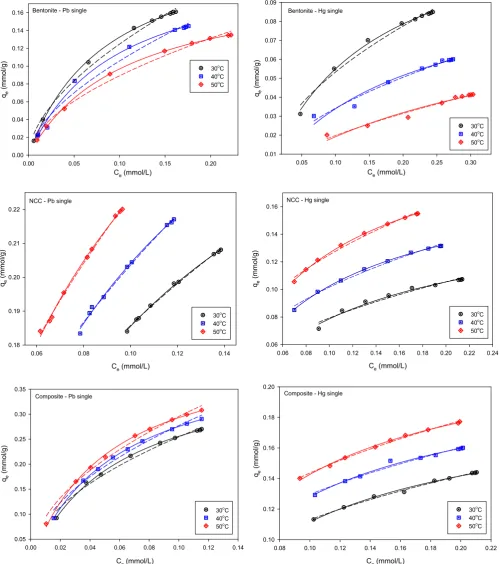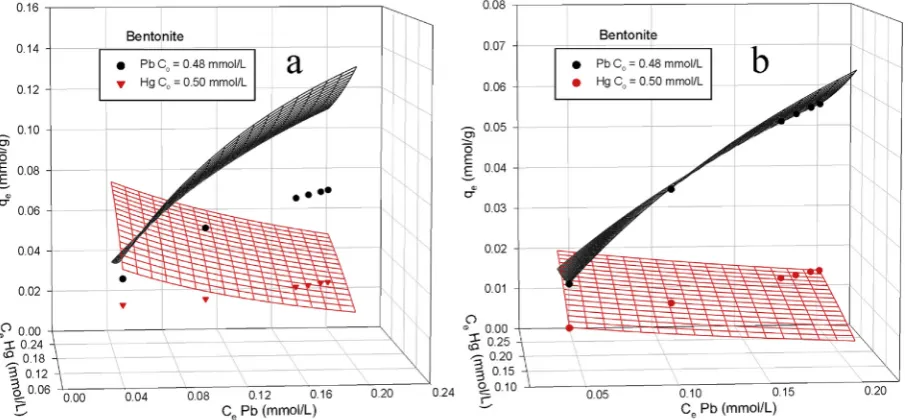Investigation of heavy metal adsorption in binary system by
nanocrystalline cellulose
e
Bentonite nanocomposite: Improvement
on extended Langmuir isotherm model
Jindrayani Nyoo Putro
a, Shella Permatasari Santoso
a, Suryadi Ismadji
a,b,*, Yi-Hsu Ju
a,** aDepartment of Chemical Engineering, National Taiwan University of Science and Technology, No. 43, Sec 4, Keelung Rd, Da'an District, Taipei City, 106,Taiwan
bDepartment of Chemical Engineering, Widya Mandala Surabaya Catholic University, Kalijudan 37, Surabaya, 60114, Indonesia
a r t i c l e
i n f o
Available online 21 March 2017Keywords:
The preparation of NCCebentonite nanocomposite using waste paper as the source of NCC was con-ducted in this study. The adsorption performance of the composite was tested for the removal of Pb(II) and Hg(II) from aqueous solution in single and binary systems. Langmuir and Freundlich adsorption isotherms were employed to correlate pure component adsorption isotherm. Langmuir equation can represent the experimental data better than Freundlich, theqmfor lead is higher than mercury in both
systems (single systemqm¼0.44 mmol/g (Pb) and 0.23 mmol/g (Hg) for composite). All systems exhibit
endothermic process, except for bentonite which shows the exothermic process. The modification of extended Langmuir model for a binary system with the inclusion of fractional loading and heat of adsorption was proposed in this study. The modified extended Langmuir model could represent the experimental data better than original extended Langmuir equation.
©2017 Elsevier Inc. All rights reserved.
1. Introduction
The rapid grow of industrialization in the 21st century makes the human life much easier. On the other hand, these rapid de-velopments ruin the environment with many kinds of industrial hazardous wastes. One of the biggest problems that the human encountered today is clean water shortage and severe water pollution. Contamination of water resources with various kind of industrial hazardous substances becomes one of the biggest prob-lems for underdeveloped and some of developing countries.
Heavy metals are some of the most harmful contaminants which usually were found in the polluted water environments. Heavy metals in contaminated water such as lead and mercury can highly damage human health and other living organisms. Pro-longed exposure to these metals can cause blood and brain
disorders. Reducing or eliminating the heavy metals content of wastewater before discharging to the water environment is a way to handle this major environment problem. Adsorption is one of the various techniques which is widely used for removing
contami-nants in water. This process is a very efficient and economical
method which results in high-quality water decontamination[1].
Recently, natural polymer adsorbents have been given tremen-dous attention as biosorbents due to their ubiquitous, biodegrad-ability, and non-toxic nature. One of the natural polymers that has potential application as biosorbent is cellulose. Cellulose is considered as the most abundant natural material in the world, which is composed of linear polysaccharides consisted of two
anhydroglucose rings linked by repeated
b
-1,4 glycoside bonds[2].Cellulose is an important raw material for many kinds of industries, especially for pulp and paper industries. In 2014, the total graphic papers (newsprint, uncoated mechanical, uncoated woodfree, and coated papers) consumption was 56 Mt for Europe and Northern America region; then it can be assumed that the waste paper has
the same amount of the total consumption number[3]. Waste
pa-pers usually are used as feedstocks for making recycled paper.
However, after several times of recycling, cellulosefibers become
short and has lower economic value than long cellulosefibers. To
increase the added value of waste paper, the possibility of utilizing *Corresponding author. Department of Chemical Engineering, Widya Mandala
Surabaya Catholic University, Kalijudan 37, Surabaya, 60114, Indonesia.
**Corresponding author. Department of Chemical Engineering, National Taiwan University of Science and Technology, No. 43, Sec 4, Keelung Rd, Da’an District, Taipei City, 106, Taiwan.
E-mail addresses:[email protected](S. Ismadji),[email protected]. tw(Y.-H. Ju).
Contents lists available atScienceDirect
Microporous and Mesoporous Materials
j o u r n a l h o m e p a g e : w w w . e l s e v i e r . c o m / l o c a t e / m i c r o m e s o
http://dx.doi.org/10.1016/j.micromeso.2017.03.032
1387-1811/©2017 Elsevier Inc. All rights reserved.
waste paper as raw material for nanocrystalline cellulose (NCC) production was explored in this study.
Cellulose has hydroxyl functional groups that can be modified to
enhance its adsorption ability as an adsorbent. Currently, several
methods are available for the modification of cellulose such as
esterification, etherification, cationization, oxidation, amidation,
and grafting. Among these methods, esterification through acid
hydrolysis has been shown to improve cellulose properties excel-lently. Acid hydrolysis is a simple method to modify cellulose.
Basically the acid will attack the amorphous part in cellulosefiber
and extract the nanocrystalline cellulose (NCC). Sulfuric acid pre-pared NCC is well known for excellent thermal stability property due to the attachment of sulfate esters on the NCC surface. The presence of sulfate ester in the NCC surface increases the adsorp-tion capacity two times of that of the original NCC, which means
that modification of functional groups indeed has a major impact
on adsorption capacity[4].
Bentonite is one kind of clay material which has 2:1 layer structure in which the octahedral sheet is sandwiched between two tetrahedral silica sheets, with water and metal cations existing
between the spaces of the layers [5]. The layers are negatively
charged and held together by charge-balancing counterions like
Ca2þand Naþ. Natural bentonite has been known to have moderate
adsorption capacity towards heavy metals and certain organic substances due to high cation exchange capacity (CEC), which is
around 40e130 meq/100 g and high surface charge in their lattice
structure [6]. However, due to its hydrophilic nature, natural
bentonite is not a good adsorbent for many organic compounds.
Therefore, modification of natural bentonite is necessary to
in-crease its adsorption capacity. The combination of clay and other materials such as metal oxides and polymers has gained much attention from researchers in recent years. These clay based com-posite materials have excellent capability for removing various
organic and inorganic contaminants[5,7].
The aim of this study was to use waste paper as raw material for the synthesis of NCC, and combining this NCC with bentonite to
produce a nanocomposite material for removing Pb2þand Hg2þin
single and binary systems. Improvement of extended Langmuir model to represent the adsorption isotherms of the binary system was also given in this study. The adsorption performance of the adsorbents was also tested. The mechanism of the adsorption was investigated from isotherm and thermodynamic viewpoints.
2. Materials and methods
2.1. Materials
Waste printing paper used in this study was obtained from our laboratory. The ink type for printing in this waste paper was toner from HP LaserJet Q7553A. Bentonite was obtained from Pacitan, East Java, Indonesia. The cation exchange capacity of this natural bentonite was 44.7 meq/100 g. The chemical composition of natural bentonite was analyzed using PANalytical MiniPal QC energy
dispersive X-ray fluorescence, and the results are as follows:
Al2O3 ¼ 19.21%, SiO2 ¼ 61.98%, Na2O ¼ 2.22%, CaO ¼ 3.59%,
K2O ¼1.78%, MgO ¼ 1.98%, Fe2O3 ¼ 2.97%, MnO ¼ 0.22%, and
TiO2¼0.09%. Analytical grade NaOH, HCl, KNO3, Pb(NO3)2, HgCl2,
chloroform, dimethyl sulfoxide, sulfuric acid, hydrogen peroxide,
were used without further purification.
2.2. Pretreatment of waste paper and bentonite
Waste paper (5 g) was soaked in tap water overnight and shredded using a blender. The shredded paper was then deinked with 100 ml organic solvent that was 30% chloroform (99% purity)
and 70% dimethyl sulfoxide (99.7% purity). Deinking was conducted under continuous stirring for 2 h at room temperature. Subse-quently, the solution was sonicated for 15 min, and the waste paper
was filtered. The collected waste paper was dried in an oven
overnight and kept in a desiccator for further use.
Before use, bentonite was purified in 30% hydrogen peroxide
solution at room temperature for 24 h under continuous stirring to remove organic impurities. The weight ratio of bentonite and hydrogen peroxide solution was 1:5. Then the mixture was heated in boiling water for 2 h to remove excess hydrogen peroxide. The
purified bentonite was separated from the solution by
centrifuga-tion and washed with distilled water, then dried at 110C for 24 h.
2.3. Preparation of NCC/Bentonite composite
The deinked waste paper (1 g) was dissolved in 1 M NaOH (9 g)
to remove impurities and swell the cellulosefiber. The solution was
stirred for 3 h at room temperature and dried in an oven at 50C for
6 h. Then 1 g of waste paper was treated with 20 ml of 64 wt.%
H2SO4at 45C for 60 min under continuous stirring. After
hydro-lysis, the solid and liquid were separated by centrifugation (9503 g, 10 min). The turbid supernatant was collected and placed in a dialysis tube for 3 days. The suspension was sonicated for 30 min in
an ice-water bath to avoid overheating and kept in a 20 C
refrigerator for 24 h. Subsequently, the suspension was freeze-dried to obtain the NCC powder.
Preparation of NCC - bentonite nanocomposite was conducted
according to the previous method[8]with modifications. Bentonite
(0.6 g) was dispersed in DI water (30 ml), stirred for 1 h and sub-sequently sonicated for 1 h. The bentonite was added to 0.1% of NCC dispersion (30 g) and stirred for 24 h. Then the solution was soni-cated for 1 h. The nanocomposite formed was poured into a
poly-styrene Petri dish and oven dried at 50C for 1 day.
2.4. Characterization
Field emission scanning electron microscope (FESEM, JEOL JSM-6500F) was employed for obtaining the surface morphology of
samples. Prior to FESEM imaging, the sample was coated with a thin
layer of platinum by afine auto coater (JFC-1600, JEOL, Ltd., Japan)
for 90 s in an argon atmosphere. The FESEM analysis was conducted at 10 kV and 15 kV with 10.4 mm working distance. Transmission electron microscope (TEM, Tecnai F20 G2 FEI-TEM) was conducted at 80 kV to know the NCC morphology. The sample was prepared on a 300 mesh Cu grids with 2% uranyl acetate for staining. The
attenuated total reflectance (ATR) FTIR (Bio-Rad Model FTS-3500)
analysis was operated in the frequency range of 4000e650 cm 1
with 4 cm 1scanning resolution, and the signal was accumulated
from 100 scans. X-ray diffraction (XRD, Philips X'pert X-ray Diffractometer) patterns were acquired at 40 kV and 30 mA using a
monochromatic high-intensity Cu K
a
1radiation (l
¼0.15405 nm).The surface charge of NCC, bentonite, and composite were deter-mined using a zeta meter (Zeta Potential Analyzer, Brookhaven
90Plus). The thermal stability of NCC, bentonite, and composite was determined by thermal gravimetry analysis (TGA) using a Perkin Elmer Diamond TG/DTA thermal analyzer with a heating and
cooling rate of 10C min 1up to 600C under continuous nitrogen
gasflow of 150 ml min 1. Sample mass in each experiment was
about 5 mg.
2.5. Adsorption experiment
Adsorption of lead and mercury was conducted in batch mode. For single system, a stock solution of Pb(II) or Hg(II) was prepared
by dissolving 159.85 mg of Pb(NO3)2or 135.36 mg of HgCl2into a
liter of distilled water. The adsorption experiments were conducted
by introducing various masses (0.1e2.0 g) of NCC, bentonite,
nanocomposite into a series of conicalflasks containing 50 ml of
Fig. 2.Morphological image of (A) waste paper, (B) paper after treatment, (C) bentonite, (D) NCC, (E) composite, and (F) TEM of NCC.
lead or mercury at a certain pH value. The pH was previouslyfixed
at a range of 2e7 by adding 0.1 M HCl or NaOH solution into the
heavy metal solution. The effect of temperature on adsorption isotherm was studied by carrying out the adsorption at 30, 40, and
50C. After equilibrium condition was reached, the solution was
separated from the adsorbent by centrifugation (6082 g, 10 min).
Thefinal concentration of Pb(II) and Hg(II) was measured using
ICP-OES. Adsorbed Pb(II) and Hg(II) at equilibrium condition per unit
mass of adsorbent (qe) was calculated using the following equation:
qe¼ComCeV (1)
whereqeis the amount of Pb(II) or Hg(II) adsorbed on the adsorbent
(mmol/g) at equilibrium condition, Co andCe are the initial and
equilibrium concentrations (mmol/L), respectively.Vis the volume
of solution (L), andmis the mass of adsorbent (g).
For a binary system, a known amount of Pb (159.85 mg, 319.70 mg, 479.55 mg) was added into 1 L Hg solution (135.36 mg).
The binary adsorption was conducted at 30C and pH 2, 6 and 5 for
NCC, bentonite and composite, respectively. The amount of Pb(II) and Hg(II) adsorbed at equilibrium condition per unit mass of
adsorbent (qe) was calculated using the following equation:
qe;i=j¼
Co;i=j Ce;i=j
m V (2)
whereqe;iandqe;jare the amount of Pb(II) and Hg(II) adsorbed on
the adsorbent (mmol/g) at equilibrium condition, respectively,Co,i/j
andCe,i/jare the initial and equilibrium concentrations (mmol/L),
respectively.
3. Results and discussion
3.1. ATR FTIR analysis
ATR-FTIR is the most widely used technique for characterization of materials based on the vibrations of atoms within the molecules. Fig. 1represents the spectra of waste paper, deinked waste paper,
purified bentonite, NCC, and composite. Both waste paper and
deinked waste paper spectra show the cellulose characteristic
peaks as indicated by CeO/CeC stretching (1045 cm 1), CeH
bonding (1357 cm 1), and CH
2symmetrical stretching (2841 cm 1)
[9,10]. From these spectra, there are two prominent different peaks.
The peak at 1730 cm 1 for waste paper corresponds to carbonyl
band that is usually found in toner such as styrene acrylate
copolymer[11,12]. The appearance ofeOH group (3291 cm 1) in
deinked waste paper can be explained by the removal of toner that
previously covered up theeOH groups on the cellulosefiber[9]. All
the characteristics of cellulose from deinked waste paper are
retained in NCC. New peak appears for NCC in 1407 cm 1which
indicates the presence of sulfate esters due to sulfuric acid hydro-lysis. FTIR spectrum of bentonite shows the characteristics of
montmorillonite clays as demonstrated by Al(Mg)eOH stretching
(3612 cm 1), HeOeH stretching (3441 cm 1), eOH bending for
adsorbed water (1641 cm 1) and Si
eOeSi stretching of the
tetra-hedral sheet (1041 cm 1)[5,13,14]. The characteristic peaks of NCC
and bentonite seem to be retained as indicated in the
nano-composite spectrum. The wavenumber 1083 cm 1 indicates the
SieO in bentonite, the shifting of the peak of silica from 1041 cm 1
to 1083 cm 1was possibly due to the exfoliated off the tetrahedral
sheet by NCC. The wavenumber of AleOHeMg appears at
3640 cm 1which was slightly altered from 3612 cm 1. The
wave-numbers of 2775 cm 1and 3207 cm 1corresponded to the CeH
bond and bonded OH from NCC, respectively.
Fig. 3.X-ray diffraction of adsorbents.
Fig. 4.TGA curve for the characterization of bentonite, NCC and composite.
3.2. Surface morphology analysis
The surface morphologies of waste paper, deinked waste paper,
bentonite, NCC, and nanocomposite are shown inFig. 2. It can be
seen from the image of waste paper that there were toner particles
on the surface of cellulosefiber (Fig. 2a). After pretreatment, toner
particles were removed and thefiber seems to be swollen due to
NaOH pretreatment (Fig. 2b). The swelling of cellulosefibers helped
to create homogeneous NCC particles. The SEM image of bentonite (Fig. 2c) reveals that the surface topography of bentonite consists of stacked sheets with heterogeneous surfaces. It can be seen from the surface topography of NCC (Fig. 2d) that NCC has a crystal structure. The TEM result of NCC (Fig. 2f) indicates that NCC possesses a rod crystal morphology with length around 157 nm. The morphology of composite (Fig. 2e) is similar to the bentonite morphology but with a smoother surface.
3.3. X-ray diffraction
The crystalline phase of materials was observed by XRD. The characteristic peaks of montmorillonite in bentonite (Fig. 3) are at
19.7and 22. The other diffraction peaks belong to quartz (26.5,
42.1, and 51) and FeCaCO
3(35.8)[15]. Crystal plane of 200 at
22.3represents the crystalline part of cellulose in NCC diffraction
graph, the broad peak around 14
e16.5indicates the crystal plane
of 110 [16]. Continuous and broad peak was observed in XRD
pattern of composite between 21.7and 23denoting the
combi-nation of the crystalline part between bentonite and NCC which have been exfoliated within each other.
3.4. Thermal gravimetry analysis (TGA)
The thermal characteristic of NCC, bentonite, and composite was characterized using thermogravimetry analysis, and the results are
given inFig. 4. TGA result of NCC shows that three different stages
of weight loss occurred during the heating process. Thefirst stage
of weight loss was due to the evaporation of moisture content
(30e200C) and it was found that the moisture content of NCC was
around 6.5%. The second stage of the weight loss occurred at
245e315C. In this stage, the weight loss of the sample (~58.3%)
was mostly due to thermal degradation (dehydration and depoly-merization of cellulose). In the last stage, the weight loss was
mostly due to the carbonization of intermediate chars [17]. For
bentonite, it was observed that there are two stages in TGA curve.
Thefirst stage corresponds to the evaporation of moisture content
and the second stage was due to the dehydroxylation of
alumino-silicate in bentonite [18]. The thermogravimetric curve of the
composite shows a similar trend to that of the thermal degradation of the composite of NCC and bentonite, with the degradation of
cellulose starting at between 215 and 315C and dehydroxylation
phase at 315e590C.
Fig. 6.Effect of pH on the adsorption of (a) Pb single, (b) Hg single, (c) Pb binary and (d) Hg binary.
3.5. Zeta potential
Zeta potential of each adsorbent was measured to obtain the
isoelectric point. From Fig. 5, it can be seen that the surface
charge of bentonite and composite is pH dependent. The
iso-electric point is where the adsorbent has no charge at specific pH
value. Isoelectric points for bentonite and composite are at pH 5.4 and 3.6, respectively. The surface charge of NCC is pH
indepen-dent as seen inFig. 5. The surface charge of NCC is almost
con-stant (~ 20 mV) at all pH which indicates excellent stability of NCC at various pH.
3.6. Effect of pH
pH has been known to have a strong influence on the adsorption
of heavy metals onto various adsorbents.Fig. 6depicts the effect of
pH on the adsorption of Pb(II) and Hg(II) onto bentonite, NCC, and nanocomposite. The pH optimum for adsorption of Pb(II) and Hg(II) onto bentonite both in the single or binary system was achieved at pH 6. For NCC in single system, the pH optimum for adsorption of Hg(II) was pH 2 while for Pb(II) was pH 3. For the adsorption of Hg(II) and Pb(II) onto nanocomposite, the pH optimum in single system for adsorption Hg(II) was pH 4, while for Pb(II) was pH 5. In binary adsorption process, the optimum pH for NCC was 2 and 5 for composite. Slight change in the optimum pH of binary adsorption process for NCC and composite denotes that surface charge of NCC
has a quite significant role in the binary adsorption, as discussed
previously that NCC has good stability at the various condition of pH.
The isoelectric point of bentonite is at pH 5.4 as indicated in Fig. 5. Below this isoelectric point, the bentonite is positively charged while above this point the bentonite is negatively
charged. At pH 6, lead ions are present in the forms of Pb(II) and
PbOHþ. Since the surface of the bentonite is negatively charged,
therefore, electrostatic interaction between lead cations and the surface of bentonite occurred, resulting in the increased amount of lead cations adsorbed onto the surface of bentonite. A similar
phenomenon also took place in the adsorption of Hg(II) onto
bentonite. At pH 6, the mercury ions exist in the forms of HgOHþ
and HgOHCl[19,20] and the interaction between the surface of
bentonite and HgOHþ is electrostatic, while with HgOHCl it is
through van der Waals force.
Fig. 8.Adsorption isotherms of single system in 30, 40, and 50C (solid line: Langmuirfitting, dashed line: Freundlichfitting).
In the case of the adsorption of heavy metals onto NCC, since the surface of the NCC is negatively charged at all pH, the adsorption mechanism is obviously electrostatic interaction be-tween negatively charged NCC and metal cations. The presence of hydroxyl and sulfonate functional groups on the surface of NCC also enhanced the adsorption capacity of NCC towards Pb(II) and Hg(II).
The combination of bentonite and NCC as nanocomposite greatly enhanced the adsorption removal of Pb(II) and Hg(II) as can
be seen inFig. 6. The mechanism of the adsorption of Pb(II) and
Hg(II) onto nanocomposite is the electrostatic interaction between metal ions and negatively charged surface of the nanocomposite. In general, for all adsorbents the adsorption of Pb(II) is more prefer-able to Hg(II) (including in the binary system). Based on the elec-tronegativity values (2.00 for Hg and 1.87 for Pb), the adsorption behavior should be opposite, i.e. Hg(II) should be adsorbed easier
onto the surface of the adsorbents than Pb(II) [21]. Since this
adsorption phenomenon cannot be explained by the electronega-tivity of the metals, we will explain it further with the effect of van der Walls radius (150 pm for Pb and 200 pm for Hg) which is
defined as the half of the internuclear distance of two atoms[22].
With a larger van der Walls radius, the forces in mercury are weaker
than in lead. Thus the chance of mercury to create higher affinity is
better than lead. However the results (Fig. 6c and d) indicate that the adsorbents have better interaction with Pb(II) than Hg(II). Since the van der Walls radii concept also cannot explain this adsorption phenomenon, we will try another approach.
Pearson's principle states that hard acids prefer to bind to hard
bases and soft acids to soft bases. Hg2þis a soft acid while Pb2þis a
borderline acid[23]. For bentonite, interaction with Pb(II) is
pref-erable because in its structure there are exchangeable cations (hard acid) and water (hard base) in the midst of bentonite layers, hence Pb(II) can form attractive forces with hard acid and a hard base.
Since NCC has hydroxyl and sulfite anion which are hard base and
borderline base, respectively and the pH is acid (2e3) which makes
low Hg(II) affinity towards adsorbents hence adsorption is not as
strong as in the case of Pb(II). The schematic diagram of this
adsorption mechanism can be seen inFig. 7.
3.7. Adsorption isotherms in single system
Various models have been developed to represent liquid phase adsorption equilibria data. The most common used
adsorption isotherms models are Langmuir and Freundlich. Both
isotherm equations consist of two parameters. Langmuir
adsorption isotherm is based on assuming homogeneous surface and energy on the adsorbent surface, while Freundlich is an empirical model for heterogeneous systems. Both models have been extensively used to represent huge numbers of adsorption
experimental data since these equations are simple and can fit
the data in a specific concentration range. Langmuir (Eq. (3))
and Freundlich (Eq.(4)) models are mathematically expressed as
follows:
qe¼qm1KLCe
þKLCe (3)
qe¼KFCe1=n (4)
whereqmis the Langmuir constant which indicates the maximum
adsorption capacity of the adsorbent with monolayer surface
coverageðmmol=gÞ, andKLis the adsorption affinity constant (L/
mmol).KFis the Freundlich constant which expresses the
adsorp-tion capacity [(mmol/g)(mmol/L)1/n] and n is the dimensionless
unit representing the surface heterogeneity. A highernreflects that
the adsorption system is more heterogeneous.
The adsorption experimental data werefitted to the
adsorp-tion equaadsorp-tions using nonlinear regressionfitting, and the results
are shown inFig. 8. It can be seen that thefitting results (Table 1)
indicate that Langmuir model fits the experimental data better
than Freundlich model. Correlation coefficient factors (R2) for
Langmuir models are around 0.95e0.99. From Table 1it can be
seen that all of the parameters of Langmuir and Freundlich
models are temperature dependent. For heavy metalsebentonite
system, qmax and KL decreased with increasing temperature,
while for other systems, these parameters increase with the in-crease of temperature. The inin-crease of uptake amount with temperature is a strong indication that chemisorption is the control mechanism of the adsorption process. Physical adsorption is the main control mechanism of the adsorption of Pb(II) and Hg(II) onto bentonite.
In chemisorption mechanism, the adsorbate molecules are strongly attached to the surface of the adsorbent. This
phenom-enon is indicated by KL in Langmuir equation. The stronger the
interaction between adsorbate and adsorbent, the higher the
value ofKL. The values ofKLfor NCC and nanocomposite systems
Table 1
Langmuir and Freundlich parameters for single adsorption system at various temperatures.
Adsorbent Adsorbate T (C) Langmuir parameters Freundlich parameters
qm(mmol/g) KL(L/mmol) R2 KF((mmol/g)(mmol/L)1/n) n R2
Bentonite Pb 30 0.25 11.52 0.99 0.47 1.72 0.99
40 0.22 10.50 0.99 0.41 1.67 0.98
50 0.20 9.37 0.99 0.32 1.79 0.99
Hg 30 0.13 6.59 0.99 0.18 1.85 0.98
40 0.10 4.65 0.95 0.13 1.77 0.98
50 0.09 2.54 0.95 0.09 1.51 0.97
NCC Pb 30 0.30 15.51 0.99 0.42 2.83 0.99
40 0.33 16.14 0.99 0.49 2.58 0.99
50 0.35 18.19 0.99 0.57 2.42 0.99
Hg 30 0.16 9.68 0.98 0.20 2.43 0.96
40 0.18 11.96 0.99 0.25 2.50 0.99
50 0.22 13.31 0.99 0.31 2.54 0.99
Composite Pb 30 0.40 17.25 0.99 0.80 2.00 0.98
40 0.43 17.46 0.99 0.88 1.99 0.98
50 0.44 19.33 0.99 0.92 2.01 0.98
Hg 30 0.19 13.50 0.99 0.24 3.05 0.99
40 0.21 15.13 0.99 0.26 3.26 0.98
are higher than those in heavy metals - bentonite system as
indicated in Table 1. Both NCC and nanocomposite possess
hy-droxyl and sulfonate functional groups on their surface, and usually, the binding of these functional groups and heavy metal ions are mostly through electrostatic interaction which is much stronger interaction than van der Walls force. The basic structure of bentonite is a layer consisting of two inward-pointing tetra-hedral sheets with a central alumina octatetra-hedral sheet (2:1). In this 2:1 layer structure, water, and other cations exist and these layers also have intermolecular forces which can be much stronger than the interaction of heavy metal molecules, and the surface layer of bentonite, hence heavy metals ions are not able to
penetrate into Stern-Gouy layer between those layers [24].
Therefore, lower adsorption affinity was observed for heavy
metalsebentonite system.
3.8. Adsorption isotherms of binary system: improvement of extended Langmuir model
Among of the available models for multicomponent adsorption, the extended Langmuir possibly is the most widely used one to describe binary adsorption data, because it is simple and can represent the experimental data comparatively better than other models. The extended Langmuir is expressed as follows:
qe;i¼qm;i
KL;iCe;i
1þSn
j¼1KL;iCe;i
(5)
For binary system, Eq.(5)becomes
qe;1¼qm;1
whereqm,iandKL,iin Eqs.(6) and (7)are Langmuir constants which
are obtained from thefitting of adsorption experimental data of
single system or pure component. This model has been developed for competitive multicomponent adsorption with respect to the
energy of adsorption in system [25]. In real multicomponent
adsorption system, competition between adsorbates molecules for active sites always occur, and this phenomenon usually acts as the controlling mechanism. However, the shortcoming of the original extended Langmuir model is that it does not consider the compe-tition of adsorbate molecules on the active adsorption sites of adsorbent. The absence of the competition between the adsorbates molecules in this model often results in overestimate of the
theo-retical values of the isotherm[26]. Thus an improvement for this
model is proposed in this work to predict the binary components adsorption equilibria. Regarding the competition of adsorption of molecules onto one of the available active surface sites, the
Lang-muir constantsqmandKLare modified in terms of fractional loading
as follows:
where
q
1andq
2are the fractional loading of component 1 and 2in the surface of adsorbent, respectively, whileQ1andQ2are the
heat of adsorption of component 1 and 2, respectively. As
mentioned in the previous section, the Langmuir affinity constant
measures how strong the adsorbate molecules are attached or attracted onto the surface of the adsorbent. Basically, the
frac-tional loading
q
and heat of adsorption Q will influence theLangmuir affinity constant as indicated in Eqs. (10) and (11). In
Eqs.(10) and (11), the competition between adsorbate molecules is expressed as the ratio of the multiplication between the heat of adsorption and fractional loading of certain adsorbate to the summation of those values for both components. Taking into account that the competition occurred in the adsorption system,
adsorption affinity in the binary system should be lower than in
single system. The introduction of fractional loading in Eqs.(10)
and (11)indicates that the contribution of surface coverage of a
Fig. 9.Plotting of experimental data against (a) original extended Langmuir and (b) modified extended Langmuir.
particular component towards the heat of adsorption. The orig-inal Langmuir equation assumes that there is no interaction be-tween adsorbed molecules implying that the heat of adsorption is
independent of coverage [27], and for real multicomponent
sys-tem this assumption is not truly correct. By substituting Eqs. (8)e(11), the extended Langmuir model becomes
Fig. 10.Modified extended Langmuir isotherm for lead and mercury in binary system for bentonite, NCC and composite.
Table 2
Adsorption parameters for extended Langmuir model.
Adsorbent Initial concentration q1 q2 qm,1(mmol/g) qm,2(mmol/g) KL,1(L/mmol) KL,2(L/mmol) Q1(kJ/mol) Q2(kJ/mol) Co,Pb(mmol/L) Co,Hg(mmol/L)
Bentonite 0.48 0.50 0.66 0.34 0.16 0.05 5.21 3.61 8.31 20.00
0.97 0.50 0.67 0.33 0.17 0.05 5.23 3.60
1.45 0.50 0.67 0.33 0.17 0.05 5.26 3.59
NCC 0.48 0.50 0.68 0.32 0.21 0.05 8.18 4.57 6.62 12.61
0.97 0.50 0.68 0.32 0.21 0.05 8.22 4.55
1.45 0.50 0.69 0.31 0.21 0.05 8.27 4.52
Composite 0.48 0.50 0.70 0.30 0.28 0.06 10.87 4.99 4.74 6.46
0.97 0.50 0.70 0.30 0.28 0.06 10.91 4.96
This fractional loadingð
q
Þwas originally developed by Langmuirwhich represents the fraction of the surface[28]. Now by assuming
monolayer coverage of surface active sites, then in the binary sys-tem, the total of fractional loading must be equal to unity
ð
q
1þq
2¼1Þsince the surface active sites will be occupied by eitherof Pb(II) or Hg(II) to form the monolayer surface coverage. The value
ofQcan be obtained by the following equations:
KL;1ðsingleÞðTÞ ¼KLo;1exp
temperature (K),KLis the Langmuir affinity constant that can be
determined from a single system (L/mmol). The value ofKLoandQ
are simply acquired through linear regression plotting ofKLðsingleÞ
versus 1=Tin whichKLoandQ are obtained as intercept and slope,
respectively[29].
To get a clear idea whether this proposed model is applicable,
the experimental data (0.48 mmol/L Pb(II)þ0.50 mmol/L Hg(II))
were plotted against the original extended Langmuir and modified
extended Langmuir and the results are presented inFig. 9. It can be
seen that the original extended Langmuir (Fig. 9a) can notfit the
experimental data well. On the other hand, the modified extended
Langmuir canfit the experimental data very well, confirming that
the competition between adsorbates molecules occurred during the adsorption process. The binary adsorption of Pb(II) and Hg(II)
onto bentonite, NCC and nanocomposite werefitted using Eqs.(12)
and (13)and the results are presented inFig. 10andTable 2. It can be seen that at the same concentration of lead and mercury in the
mixtures, the fractional loading of Hg(II) (
q
2) is smaller than Pb(II),indicating that Hg(II) is less preferentially adsorbed on all adsor-bents. These results have the same trend as the single component
adsorption. Even the value of
q
1which refers to the fractionalsur-face coverage of Pb(II) increases as the concentration of Pb(II) in the mixture increases for bentonite and NCC, but it remains unchanged for nanocomposite. This shows that composite attained maximum surface coverage for Pb(II) although the concentration of Pb(II) was three times higher than the initial concentration. The adsorption of Pb(II) and Hg(II) onto bentonite is exothermic, while both NCC and composite show endothermic adsorption. This correlates well with the adsorption in single system in which the adsorption capacity of NCC and composite increased with increasing temperature.
4. Conclusion
The feasibility of using NCC e bentonite nanocomposite as
adsorbent for the removal of Pb(II) and Hg(II) was presented in this paper. The adsorption studies were conducted in single and binary
systems. Langmuir isotherm gives better fit through all of the
experimental data for the single system. The value of optimum pH for binary systems is not much different with the single system,
which confirms that the adsorption mechanism in both of single
and binary systems was similar. The adsorption capacity for lead is higher than mercury in both systems; this phenomenon indicated that functional group plays a major role in the adsorption
mecha-nisms. The modified model could represent the binary
experi-mental data very well.
References
[1] G. Crini, Recent developments in polysaccharide-based materials used as adsorbents in wastewater treatment, Prog. Polym. Sci. 30 (2005) 38e70. [2] S.J. Einchorn, A. Dufresne, M. Aranguren, N.E. Marcovich, J.R. Capadona,
S.J. Rowan, S. Weder, W. Thielemans, M. Roman, S. Renneckar, W. Gindl, S. Veigel, J. Keckes, H. Yano, K. Abe, M. Nogi, A.N. Nakagaito, A. Mangalam, J. Simonsen, A.S. Benight, A. Bismarck, L.A. Berglund, T. Peijs, Review: current international research into cellulose nanofibers and nanocomposites, J. Mater. Sci. 45 (2010) 1e33.
[3] UNECE/FAO, Forest Products Annual Market Review 2014e2015, United
Nation Publications, 2015.
[4] R. Batmaz, N. Mohammed, M. Zaman, G. Minhas, R.M. Berry, K.C. Tam, Cel-lulose nanocrystals as promising adsorbents for the removal of cationic dyes, Cellulose 21 (2014) 1655e1665.
[5] S. Ismadji, D.S. Tong, F.E. Soetaredjo, A. Ayucitra, W.H. Yu, C.H. Zhou, Bentonite hydrochar composite for removal of ammonium from Koifish tank, Appl. Clay Sci. 119 (2016) 146e154.
[6] H.H. Murray, Applied Clay Mineralogy: Occurrences, Processing and Applica-tion of Kaolins, Bentonites, PalygorskiteeSepiolite, and Common Clays,first
ed., Elsevier, Amsterdam, 2007.
[7] R. Srinivasan, Advances in application of natural clay and its composites in removal of biological, organic, and inorganic contaminants from drinking water, Adv. Mater. Sci. Eng., http://dx.doi.org/10.1155/2011/872531(Article ID 872531).
[8] C.N. Wu, T. Saito, S. Fujisawa, H. Fukuzumi, A. Isogai, Ultrastrong and high gas barrier nanocellulose/clay-layered composites, Biomacromolecules 12 (2013) 1927e1932.
[9] H.G. Higgins, C.M. Stewart, K.J. Harrington, Infrared spectra of cellulose and related polysaccharides, J. Polym. Sci. 51 (1961) 59e84.
[10] P. Garside, P. Wyeth, Identification of cellulosicfibres by FTIR spectroscopy: thread and siglefibre analysis by attenuated total reflectance, Stud. Conserv. 48 (2003) 269e275.
[11] J. Lee, S.H. Kim, Y.J. Cho, Y.S. Nam, K.B. Lee, Y. Lee, Characterization and sequence determination of pen inks, read sealing inks, and laser toners by TOF-SIMS and ATR FTIR, Surf. Interface Anal. 46 (2014) 317e321.
[12] R.A. Merrill, E.G. Bartick, J.H. Taylor III, Forensic discrimination of photocopy and printer toners. I. The development of an infrared spectral library, Anal. Bioanal. Chem. 376 (2003) 1272e1278.
[13] F.E. Soetaredjo, A. Ayucitra, S. Ismadji, A.L. Maukar, KOH/bentonite catalysts for transesterification of palm oil to biodiesel, Appl. Clay Sci. 53 (2011) 341e346.
[14] A. Kurniawan, H. Sutiono, N. Indraswati, S. Ismadji, Removal of basic dyes in binary system by adsorption using rarasaponin-bentonite: revisited of extended langmuir model, Chem. Eng. J. 189e190 (2012) 264e274. [15] Y. Li, J. Zhan, L. Huang, H. Xu, H. Li, R. Zhang, S. Wu, Synthesis and
photo-catalytic activity of a bentonite/g-C3N4 composite, RSC Adv. 4 (2014)
11831e11839.
[16] L. Heath, W. Thielemans, Cellulose nanowhisker aerogels, Green Chem. 12 (2010) 1448e1453.
[17] Y. Peng, D.J. Gardner, Y. Han, A. Kiziltas, Z. Cai, M.A. Tshabalala, Influence of drying method on the material properties of nanocellulose I: thermostability and crystallinity, Cellulose 20 (2013) 2379e2392.
[18] Y. Sarikaya, M. Onal, B. Baran, T. Alemdaroglu, The effect of thermal treatment on some of the physicochemical properties of a bentonite, Clays Clays Miner. 48 (2000) 557e562.
[19] H.C.H. Hahne, W. Kroontje, Significance of pH and chloride concentration on behavior of heavy metal pollutants: mercury(II), Cadmium(II), Zinc(II), and Lead(II), J. Environ. Qual. 2 (1973) 444e450.
[20] W.R. Knocke, L.H. Hemphill, Mercury(II) sorption by waste rubber, Water Res. 15 (1981) 275e282.
[21] L. Pauling, The Nature of the Chemical Bond, third ed., Cornell University, Ithaca, NY, 1960.
[22] A. Bondi, van der Waals volumes and radii, J. Phys. Chem. 68 (1964) 441e451. [23] R.G. Pearson, Hard and soft acids and bases, J. Am. Chem. Soc. 85 (1963)
3533e3539.
[24] H.V. Olphen, Interlayer Forces in Bentonite, Publication No. 40, Exploration and Production Research Division, Shell Development Co., Houston, Texas, 1954.
[25] S.J. Allen, G. McKay, J.F. Porter, Adsorption isotherm models for basic dye adsorption by peat in single and binary component systems, J. Colloid Inter-face Sci. 280 (2004) 322e333.
[26] A. Kurniawan, H. Sutiono, N. Indraswati, S. Ismadji, Removal of basic dyes in binary system by adsorption using rarasaponin-bentonite: revisited of extended Langmuir model, Chem. Eng. J. 189e190 (2012) 264e274. [27] D.M. Ruthven, Principles of Adsorption&Adsorption Processes,
Wiley-Inter-science, United States of America, 1984.
[28] I. Langmuir, The adsorption of gases on plane surfaces of glass, mica and platinum, J. Am. Chem. Soc. 40 (9) (1918) 1361e1403.
